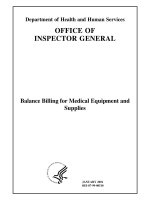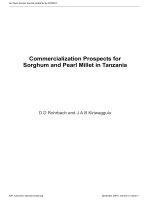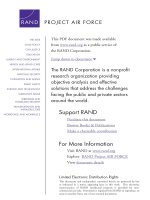Safeguarding Equipment and Protecting Workers from Amputations pot
Bạn đang xem bản rút gọn của tài liệu. Xem và tải ngay bản đầy đủ của tài liệu tại đây (1.16 MB, 78 trang )
Small Business Safety and Health Management Series
U.S. Department of Labor
Occupational Safety and Health Administration
OSHA 3170
2001
Safeguarding Equipment and Protecting
Workers from Amputations
This publication provides a generic, non-exhaustive
overview of a particular standards-related topic. This
publication does not itself alter or determine compli-
ance responsibilities, which are set forth in OSHA
standards themselves, and the Occupational Safety
and Health Act. Moreover, because interpretations and
enforcement policy may change over time, for addi-
tional guidance on OSHA compliance requirements,
the reader should consult current administrative
interpretations and decisions by the Occupational
Safety and Health Review Commission and the
courts.
Material contained in this publication is in the public
domain and may be reproduced, fully or partially,
without the permission of the Federal Government.
Source credit is requested but not required.
This information will be made available to sensory
impaired individuals upon request. Voice Phone:
(202) 693-1999; teletypewriter (TTY) number:
1-877-889-5627.
Small Business Safety and Health Management Series
U.S. Department of Labor
Occupational Safety and Health Administration
OSHA 3170
2001
Safeguarding Equipment and Protecting
Workers from Amputations
Contents
iii
Introduction 1
Who Should Read This Guide? 1
Why Is This Guide Important? 1
How Can This Guide Help Me? 1
What Does This Guide Cover? 1
Are There Specific Standards and Requirements for Safeguarding Machinery? 1
Are There Other Requirements I Need to Know About? 1
What Types of Hazards Do I Need to Look for? 2
How Can I Control Potential Hazards? 2
Recognizing Amputation Hazards 3
What Types of Mechanical Components Are Hazardous? 3
What Types of Mechanical Motions Are Hazardous? 3
What Are the Hazardous Activities Involving Stationary Machines? 5
Controlling Amputation Hazards 6
What Are Some Basic Safeguarding Methods? 6
What Are Guards? 6
What Are Some Safeguarding Devices I Can Use? 8
Are There Other Ways to Safeguard Machines? 13
What Is Guarding by Location? 13
What Is Safeguarding by Feeding Methods? 13
Can Workers Use Hand-Feeding Tools? 14
Are Foot Controls Another Option? 14
What About Controls for Machines with Clutches? 14
Do I Need to Safeguard Machinery? 15
What Administrative Issues Must Be Considered When Safeguarding Machinery? 15
Are There Standards for Machine Safeguards? 16
Identifying Hazards for Specific Types of Machinery 17
What Are Mechanical Power Presses and Their Hazards? 17
How Do I Safeguard My Mechanical Power Presses? 18
What Work Practices and Administrative Controls Should I Use? 19
What Other Controls Pertain to Mechanical Power Press Die Set-Up and Maintenance? 20
What Type of Training Should I Provide? 20
What Work Practices Should I Use? 20
What Do I Need to Know About Power Press Brakes? 20
What Are the Hazards Associated with Power Press Brakes? 21
How Can I Safeguard Power Press Brakes? 21
What About Work Practices and Administrative Controls for Power Press Brakes? 22
What Are the Hazards Associated with Conveyors? 23
What Do I Need to Know About Conveyors? 23
What Types of Engineering Controls Should I Use for Conveyors? 24
What Work Practices and Administrative Controls Do I Need to Use? 26
What Are the Hazards from Printing Presses? 27
What Types of Controls Can I Use to Safeguard Printing Presses? 28
What Are the Work Practices and Administrative Controls I Can Use for Printing Presses? 29
What Are the Hazards from Roll-Forming and Roll-Bending Machines? 29
What Engineering Controls Should I Use to Protect Employees? 30
Contents (continued)
iv
Are There Work Practice and Administrative Controls I Can Employ for These Machines? 31
What Are Shearing Machines and Their Hazards? 32
What Controls Can I Use on Shearing Machines? 33
Are There Other Controls I Can Implement? 34
What Are the Hazards Associated with Food Slicers? 35
What Types of Controls Can I Use to Safeguard Slicers? 35
What Are the Hazards of Using Meat Grinders? 36
What Are the Engineering and Other Controls I Can Use to Prevent These Hazards? 37
How Do Meat-Cutting Band Saws Pose Hazards? 38
What Safeguards Can I Use? 39
What About Drill Presses and Related Hazards? 40
What Are Some Methods for Safeguarding Drill Presses? 41
What About Milling Machines and Related Hazards? 41
What Are Some Milling Machine Safeguarding Methods? 42
What Are the Hazards of Working with Grinding Machines? 43
How Can I Safeguard Grinding Machines? 44
What Are the Hazards from Slitters? 45
What Are Some Ways to Safeguard Slitter Machines? 46
Other Sources of OSHA Assistance 48
Safety and Health Program Guidelines 48
State Programs 48
Consultation Services 48
Voluntary Protection Program (VPP) 49
Strategic Partnership Program 49
Training and Education 49
Electronic Information 49
OSHA Publications 50
Emergencies, Complaints, and Further Assistance 50
References 51
Appendices
A. Amputation Hazards Not Covered in This Guide 53
B. Amputation Hazards Associated with Other Equipment and Activities 54
C. OSHA Office Directory 55
List of Tables
Table 1. Commonly Used Machine Guards 7
Table 2. Types of Safeguarding Devices 9
List of Figures
Figure 1. Rotating Motion 3
Figure 2. Reciprocating Motion 3
Figure 3. Transversing Motion 4
Figure 4. Cutting Action 4
Figure 5. Punching Action 4
Contents (continued)
v
Figure 6. Shearing Action 5
Figure 7. Bending Action 5
Figure 8. Inrunning Nip Points 5
Figure 9. Fixed Guard on a Power Press 6
Figure 10. Power Press with Adjustable Barrier Guard 6
Figure 11. Self-Adjusting Guard on a Radial Saw 8
Figure 12. Interlocked Guard on Roll Make-up Machine 8
Figure 13. Pullback Device on a Power Press 8
Figure 14. Restraint Device on Power Press 12
Figure 15. Presence Sensing Device on a Power Press 12
Figure 16. Safety Triprod on a Rubber Mill 12
Figure 17. Two-Hand Control 12
Figure 18. Power Press with Gate 13
Figure 19. Power Press with Plunger Feed 13
Figure 20. Shuttle Ejection Mechanism 14
Figure 21. Typical Hand Feeding Tools 14
Figure 22. Properly Guarded Foot Control 14
Figure 23. Part Revolution Mechanical Power Press with Two-Hand Control 17
Figure 24. Hand Feeding Tools Used in Conjunction with Pullbacks on a Power Press 19
Figure 25. Power Press Brake Bending Metal 21
Figure 26. Two Person Power Press Brake Operation with Pullbacks 22
Figure 27. Belt Conveyor 24
Figure 28. Screw Conveyor 24
Figure 29. Chain Driven Live Roller Conveyor 24
Figure 30. Slat Conveyor 24
Figure 31. Roll-to-Roll Offset Printing Press 27
Figure 32. Sheet-Fed Offset Printing Press 27
Figure 33. Roll-Forming Machine 30
Figure 34. Infeed Area of a Roll-Forming Machine 30
Figure 35. Hydraulic Alligator Shear 32
Figure 36. Power Squaring Shear 32
Figure 37. Meat Slicer 35
Figure 38. Stainless Steel Meat Grinder 36
Figure 39. Stainless Steel Meat-Cutting Band Saw 38
Figure 40. Drill Press with Transparent Drill Shield 40
Figure 41. Bed Mill 42
Figure 42. Horizontal Surface Grinder 44
Figure 43. Paper Slitter 46
Introduction
Who Should Read this Guide?
Anyone responsible for the use and care of
stationary machinery—employers, employees,
safety professionals, and industrial hygienists—
should read this publication. This guide can help
you, the small business employer, identify and
manage common amputation hazards associated
with operating and using stationary equipment.
Why Is This Guide Important?
Amputations are among the most severe and
disabling workplace injuries. They are widespread
and involve various activities and equipment. (The
U.S. Bureau of Labor Statistics 1996 annual survey
indicated that there were approximately 10,000
amputations for all industry sectors.) About one-
half of all workplace amputations occur in the
manufacturing sector and the rest occur across the
construction, agriculture, wholesale and retail trade,
and service industries. These injuries result from
using stationary machines such as saws, presses,
conveyors, and bending, rolling, or shaping ma-
chines as well as from powered and non-powered
hand tools, forklifts, doors, and trash compactors;
and during materials handling activities.
How Can This Guide Help Me?
As an employer, this information will help you
protect your employees. It will help you and your
employees recognize, manage, and control the
potential hazards of the stationary machines in your
workplace. The information does not cover all
equipment associated with amputation or amputa-
tion hazards in maritime and agriculture operations.
What Does This Guide Cover?
The first two sections of the document, Recog-
nizing Amputation Hazards and Controlling
Amputation Hazards, look at sources of amputa-
tions and how to safeguard machinery. The section
on Specific Machinery, Hazards, and Safeguards
deals with the hazards and safeguarding methods
for the equipment most frequently associated with
workplace amputations: mechanical power presses,
power press brakes, shears, food slicers, meat
grinders, meat-cutting band saws, drill presses,
milling machines, grinding machines, and slitting
machines. In addition, the references and appendi-
ces identify applicable OSHA standards, what
amputation hazards are not covered, and other types
of equipment associated with amputations.
Are There Specific Standards and
Requirements for Safeguarding
Machinery?
Yes. Although this guide recommends work
practices and ways to safeguard machinery, there
are legal requirements in OSHA standards that you
need to know and comply with. These include, for
example, OSHA General Industry Standards, Title
29 of the Code of Federal Regulations (CFR), Part
1910 and the Construction Industry Standards in 29
CFR 1926. Specifically, Subpart O of the General
Industry Standards and Subpart I of the Construc-
tion Standards outline the machine guarding re-
quirements for much of the equipment presented in
this publication. Consult these standards directly to
ensure full compliance with the provisions. States
with OSHA - approved plans have equivalent
standards. These and other OSHA standards and
documents are available online at www.osha.gov
Are There Other Requirements I Need to
Know About?
The American National Standards Institute
(ANSI) publishes voluntary consensus standards on
the safe care and use of specific machinery. ANSI
standards also may give you guidance for comply-
ing with OSHA performance-based standards, such
as 29 CFR 1910.212-General Requirements for all
machines. ANSI standards are sometimes incorpo-
rated into OSHA regulations, and in these cases,
employers are accountable for complying with the
specific version referenced. OSHA generally
recommends, however, that employers use the most
recent version of ANSI standards.
2
Introduction
What Types of Hazards Do I Need to
Look for?
To prevent worker amputations, you and your
employees must be able to recognize the contribut-
ing factors, such as the mechanical components of
machinery, the mechanical motion that occurs at or
near these components, and the specific worker
activities performed with the mechanical operation.
How Can I Control Potential Hazards?
Machine safeguarding is the primary way to
control amputation hazards associated with station-
ary machinery. Work practices, employee training,
and administrative controls also play an important
role in preventing and controlling these workplace
hazards. (See OSHA’s 1989 Safety and Health
Program Management Guidelines and OSHA
standards in the References section.)
Under the Fair Labor Standards Act
(FLSA), the Secretary of Labor has desig-
nated certain non-farm jobs as particularly
hazardous for employees younger than 18.
Generally, these workers are prohibited from
operating:
• band saws,
• circular saws,
• guillotine shears,
• punching and shearing machines,
• meatpacking or meat-processing
machines, and certain power-driven
machines:
- paper products machines,
- woodworking machines,
- metal forming machines, and
- meat slicers.
3
Anyone working around stationary equipment
should be able to identify potential amputation
hazards. Understanding the mechanical compo-
nents of machinery, the mechanical motion that
occurs at or near these components, and specific
worker activities performed in conjunction with
machinery operation will help workers avoid injury.
.
What Types of Mechanical Components
Are Hazardous?
Three types of mechanical components present
amputation hazards:
•Point of Operation is the area of the machine
where the machine performs work. Mechanical
actions that occur at the point of operation,
including cutting, shaping, boring, and forming.
•Power-Transmission Apparatuses are all
components of the mechanical system that
transmit energy such as flywheels, pulleys, belts,
chains, couplings, connecting rods, spindles,
cams, and gears.
•Other Moving Parts are the parts of the ma-
chine that move while the machine is operating,
such as reciprocating, rotating, and transverse
moving parts as well as lead mechanisms and
auxiliary parts of the machine.
What Types of Mechanical Motions Are
Hazardous?
All mechanical motion is potentially hazardous.
Here are the basic types of hazardous mechanical
motions:
•Rotating Motion (Figure 1) is circular motion
such as action generated by rotating collars,
couplings, cams, clutches, flywheels, shaft ends,
and spindles, that may grip clothing or otherwise
force a body part into a dangerous location.
Projections such as screws or burrs on the
rotating part increase the hazard potential.
Recognizing Amputation Hazards
•Reciprocating Motion (Figure 2) is back-and-
forth or up-and-down motion that may strike or
entrap a worker between a moving part and a
fixed object.
Figure 1. Rotating Motion
Table
Bed (stationary)
Figure 2. Reciprocating Motion
4
Recognizing Amputation Hazards
•Transversing Motion (Figure 3) is motion in a
straight, continuous line that may strike or catch
a worker in a pinch or shear point created by the
moving part and a fixed object.
•Cutting Action (Figure 4) occurs by sawing,
boring and drilling, milling, and slicing or
slitting machinery.
Figure 3. Transversing Motion
• Punching Action (Figure 5) begins when power
causes the machine to hit a slide (ram) to stamp
or blank metal or other material. The hazard
occurs at the point of operation where the
worker inserts, holds, or withdraws the stock by
hand.
Figure 4. Cutting Action
• Shearing Action (Figure 6) is powered slide or
knife movement used to trim or shear metal or
other materials generates the motion. The
hazard occurs at the point of operation where the
worker inserts, holds, or withdraws the stock by
hand.
Figure 5. Punching Action
5
• Bending Action (Figure 7) is power applied to a
slide to draw or stamp metal or other materials
generates the motion. The hazard occurs at the
point of operation where the worker inserts,
holds, or withdraws the stock by hand.
• In-Running Nip Points (Figure 8), also known
as “pinch points,” develop when two parts move
together and at least one moves in rotary or
circular motion. In-running nip points occur
whenever machine parts move toward each other
or when one part moves past a stationary object.
What Are the Hazardous Activities
Involving Stationary Machines?
Workers operating stationary machinery perform
various activities that present potential amputation
hazards:
•Machine set-up/threading/preparation,
•Normal operation,
• Clearing jams,
•Machine adjustments,
• Cleaning of machine,
• Lubricating of machine parts, and
• Scheduled and unscheduled maintenance.
When evaluating activities for potential amputa-
tion hazards, you should consider the entire opera-
tion, individual activities associated with the
operation, and the potential for injury to workers
nearby.
Recognizing Amputation Hazards
Figure 6. Shearing Action
Typical nip points include gears, rollers, belt
drives, and pulleys.
Figure 7. Bending Action
Punch
Stock
Die
Nip Point
Nip Point
Nip
Point
Nip
Point
Nip
Point
Typical Nip Point
Figure 8. Inrunning Nip Points
Blade
Stock
6
Machine safeguarding is the primary means of
controlling amputation hazards associated with
stationary machinery during normal operations. In
addition, work practices, employee training, and
administrative controls play an important role in the
prevention and control of workplace amputations.
OSHA requires adequate safeguards for all
machines and equipment generating hazardous
mechanical movement. OSHA’s general industry
and construction industry requirements for machine
guarding are listed at the end of this chapter.
What Are Some Basic Safeguarding
Methods?
Two basic methods are used to safeguard ma-
chines: guards and devices. Guards provide physi-
cal barriers that prevent access to danger areas.
Devices function by interrupting the machine’s
operating cycle to prevent workers from reaching or
entering the danger area while the machine is
cycling. Both types of safeguards should be
designed and installed to ensure worker protection.
Controlling Amputation Hazards
What Are Guards?
Guards are physical barriers that enclose danger-
ous machine parts and prevent worker contact with
them. Guards must be secure and strong. Workers
should not be able to bypass, remove, or tamper
with guards. To prevent tampering, guards typi-
cally require a tool to unfasten and remove them.
Guards should not create additional hazards such as
pinch points or shear points between guards and
other machine parts. Guards should not obstruct
the operator’s view or prevent workers from doing a
job. Metal bars, Plexiglass™, or similar guards are
suitable. Guard openings should be small enough
to prevent workers from accessing danger areas.
(See Table 1 and Figures 9 through 12 for
commonly used machine guards.)
Criteria for Machine Safeguarding
•Prevents worker contact with the hazard
area during the operating cycle.
•Avoids creating additional hazards.
• Is secure, tamper-resistant, and durable.
•Avoids interfering with normal operation
of the machine.
•Allows for safe lubrication and
maintenance.
Transparent
Insert
Entering
Stock
Exiting
Stock
Figure 9. Fixed Guard on a Power Press
Bar
Figure 10. Power Press with Adjustable
Barrier Guard
7
Table 1. Commonly Used Machine Guards
Types of Machine Guards
Type
Safeguarding
Action
Advantages
Limitations
Fixed Barrier that allows for
stock feeding but does
not permit operator to
reach the danger area.
• Can be constructed to suit
many applications.
• Permanently encloses the
point of operation or hazard
area.
•Provides protection against
machine repeat.
•Allows simple, in-plant
construction, with minimal
maintenance.
• Sometimes not practical
for changing production
runs involving different
size stock or feeding
methods.
•Machine adjustment and
repair often require guard
removal.
•Other means of protecting
maintenance personnel
often required (lockout/
tagout).
Barrier that adjusts for
a variety of production
operations.
•Can be constructed to suit
many applications.
•Can be adjusted to admit
varying stock sizes.
•May require frequent
maintenance or adjustment.
•Operator may make guard
ineffective.
Adjustable
Self-
Adjusting
Barrier that moves accord-
ing to the size of the stock
entering point of operation.
Guard is in place when
machine is at rest and
pushes away when stock
enters the point of
operation.
• Off-the-shelf guards
are often commercially
available.
•May require periodic
maintenance or adjust-
ment.
•Movable sections
cannot be used for
manual feeding.
• Some designs may be
easy to defeat.
Interlocking
•Does not provide
maximum protection.
•May require frequent
maintenance and
adjustment.
Shuts off or disengages
power and prevents
machine start-up when
guard is open. Should
allow for inching of
machine.
Replacing the guard
should not automatically
restart the machine.
• Allows access for machine
set-up, adjustment, or jam
removal without time-
consuming removal of
fixed guards when used
with hand tools or safety
blocks.
Controlling Amputation Hazards
8
Controlling Amputation Hazards
What Are Some Safeguarding Devices
I Can Use?
Safeguarding devices typically help prevent
operator contact with the point of operation. They
may be used in place of guards or as a supplemental
control when guarding alone does not adequately
enclose the hazard. Safeguarding devices either (1)
interrupt the normal cycle of the machine if the
operator’s hands are at the point of operation, (2)
prevent the operator from reaching into the point of
operation, or (3) withdraw the operator’s hands if
they are located in or near the point of operation
when the machine cycles. (See Table 2 and Figures
13 through 18 for the types of safeguarding
devices.)
Handle
Blade
Anti-
Kickback
Device
Guard
Figure 11. Self-Adjusting Guard on a
Radial Saw
Guard
Switch
Figure 12. Interlocked Guard on Roll Make-up
Machine
Wristbands
Pullback
Straps
Pullback
Mechanism
Figure 13. Pullback Device on a Power Press
9
Controlling Amputation Hazards
Table 2. Types of Safeguarding Devices
Types of Machine Devices
Type
Method of
Safeguarding
Advantages
Limitations
Pullback
Devices
Cords connected to
operator’s wrists and linked
mechanically to the ma-
chine automatically with-
draw the hands from the
point of operation during
the machine cycle.
•Allows the hands to enter the
point of operation for feeding
and removal.
•Provides protection even in
the event of mechanical
repeat.
• Close supervision ensures
proper use and adjustment.
Must be inspected prior to
each operator change or
machine set-up.
• Limits operator’s move-
ment and may obstruct
their work space.
•Operator may easily make
device ineffective by not
adjusting the device
properly.
Restraint
Devices
Wrists are connected by
cords and secured to a
fixed anchor point which
limit operator’s hands
from reaching the point of
operation at any time.
• Simple, few moving parts;
requires little maintenance.
•Operator cannot reach into
the danger area.
• Little risk of mechanical
failure; provides protection
even in the event of me-
chanical repeat.
• Close supervision required
to ensure proper use and
adjustment. Must be
inspected prior to each
operator change or ma-
chine set-up.
•Operator must use hand
tools to enter the point of
operation.
• Limits the movement of the
operator; may obstruct
work space around
operator.
•Operator may easily make
device ineffective by
disconnecting the device.
10
Table 2. Types of Safeguarding Devices (Continued)
Types of Machine Devices
Type
Method of
Safeguarding
Advantages
Limitations
Controlling Amputation Hazards
Presence-
Sensing
Devices
Interlock into the
machine’s control system
to stop operation when the
sensing field (photoelec-
tric, radio frequency, or
electromagnetic) is
disturbed.
•Adjusts to fit different stock
sizes.
•Allows access to load and
unload the machine.
•Allows access to the guarded
area for maintenance and
set-up activities.
• Restricted to machines
that stop operating cycle
before operator can reach
into danger area (e.g.,
machines with partial
revolution clutches or
hydraulic machines).
• Must be carefully main-
tained and adjusted.
• Does not protect operator
in the event of a mechanical
failure.
• Operator may make
device ineffective.
Presence-
Sensing
Mats
Interlock into machine’s
control system to stop
operation when a prede-
termined weight is
applied to the mat. A
manual reset switch must
be located outside the
protected zone.
• Full visibility and access to
the work area.
• Install as a perimeter guard
or over an entire area.
• Configure for many
applications.
• Restricted to machines
that stop operating cycle
before operator can reach
into danger area (e.g.,
machines with part-
revolution clutches or
hydraulic machines).
• Some chemicals can
degrade the mats.
•Does not protect operator
during mechanical
failures.
Safety Trip
Controls
(pressure-
sensitive
body bar,
safety
triprod,
safety
tripwire)
Stops machine when
tripped.
• Simple to use.
•Must be manually
activated.
•May be difficult to
activate due to
location.
•Protects operator only.
•May require a machine
brake.
11
Table 2. Types of Safeguarding Devices (Continued)
Types of Machine Devices
Type
Method of
Safeguarding
Advantages
Limitations
Two-Hand
Control
Requires concurrent and
continued use of both
hands, preventing them
from entering the danger
area.
•Operator’s hands are at a
predetermined location.
•Operator’s hands are free to
pick up new parts after
completion of first part of
cycle.
•Requires a partial cycle
machine with a brake and
anti-repeat feature.
•Operator may make de-
vices without anti-tiedown
ineffective.
•Protects the operator only.
Two-Hand
Trip
Requires concurrent use of
both hands, prevents them
from being in danger area
when machine cycle starts.
•Operator’s hands are at a
predetermined location.
• Can be adapted to multiple
operations.
•No obstruction to hand
feeding.
•Operator may make
devices without anti-
tiedown ineffective.
•Protects the operator only.
• Sometimes impractical
because distance require-
ments may reduce produc-
tion below acceptable
level.
•May require adjustment if
tooling changes.
•Requires anti-repeat
feature.
Type “A”
Gate
(moveable
barrier)
Applicable to mechanical
power presses. Provides
barrier between danger
area and operator (or other
workers) until completion
of machine cycle.
•Prevents operator from
reaching into danger area
during machine cycle.
•Provides protection from
machine repeat.
•May require frequent
inspection and regular
maintenance.
•May interfere with
operator’s ability to see
work.
• Can only be used on
machines with a part-
revolution clutch or
hydraulic machines.
•May require frequent
inspection and regular
maintenance.
•May interfere with the
operator’s ability to see
work.
Type “B”
Gate
(moveable
barrier)
Applicable to mechanical
power presses and press
brakes. Provides a barrier
between danger area and
operator (or other workers)
during the downstroke.
• May increase production
by allowing the operator to
remove and feed the press
on the upstroke.
Controlling Amputation Hazards
12
Controlling Amputation Hazards
Figure 15. Presence Sensing Device on a
Power Press
Figure 14. Restraint Device on Power Press Figure 16. Safety Tripod on a Rubber Mill
Tripod
Figure 17. Two-Hand Control
Control
Box
Emergency Stop
Light
Curtain
Guarded
Foot Control
Press
Bed
Light
Indicator
Key Selector
Capable of
Being Supervised
Emergency
Stop
Top Stop
13
Are There Other Ways to Safeguard
Machines?
Yes, other methods for safeguarding machines
include guarding by location or distance and by
feeding methods that prevent operator access to the
point of operation.
What Is Guarding by Location?
Safeguarding by location involves positioning or
designing a machine so that the hazardous parts are
away from areas where employees work or walk, or
alternatively, installing enclosure walls or fences
that restrict access to machines.
What Is Safeguarding by Feeding
Methods?
The feeding process can be safeguarded by
distance if the operators maintain a safe distance
between their hands and the point of operation. For
instance, if the stock is several feet long and only
one end of the stock is being worked on, the opera-
tor may be able to hold the opposite end while
performing the work. Safeguarding by distance is
Controlling Amputation Hazards
sometimes used during power press brake opera-
tions to ensure its effectiveness. This method of
safeguarding requires close supervision and
training.
Automatic and semiautomatic feeding and
ejection methods can protect the worker by mini-
mizing or eliminating direct contact with machin-
ery. These methods typically require frequent
maintenance, however, and are only protective for
normal machine operation.
Examples of semiautomatic feeding methods
include gravity feeds, where the part slides down a
chute into the point of operation and magazine
feeding, where the worker places the part in a
magazine which is then fed into the point of opera-
tion. Automatic and semiautomatic ejection meth-
ods include pneumatic (jet of air), magnetic, me-
chanical (such as an arm), or vacuum. Figures 19
and 20 illustrate different types of automatic
feeding and ejecting methods.
Figure 19. Power Press with Plunger Feed
Gate
Figure 18. Power Press with Gate
Point of
Operation
Guard
Plunger
Handle
Nest
Plunger
14
Controlling Amputation Hazards
Can Workers Use Hand-Feeding Tools?
Operators can use tools to feed work pieces into
equipment to keep their hands away from the point
of operation, but this should be done only in con-
junction with the guards and devices described
previously. Using hand tools requires close super-
vision to ensure that the operator does not bypass
their use to increase production. Tools should be
stored near the operation to encourage their use. To
prevent repetitive trauma disorders, hand-feeding
tools should be ergonomically designed for the
specific task being performed. (Figure 21 shows
typical hand-feeding tools.)
Figure 21. Typical Hand Feeding Tools
Are Foot Controls Another Option?
Foot controls are not safeguards because they do
not keep the operator’s hands out of the danger
area. If you use them, they will need some type of
guard or device, such as barriers or pullouts with
interlocks capable of controlling the start up of the
machine cycle. Using foot controls may increase
productivity, but the freedom of hand movement
allowed while the machine is operating increases
the risk of a point of operation injury. Foot controls
must be guarded to prevent accidental activation by
another worker or by falling material and not allow
continuous cycling. They work best when the
operator is in a sitting position. Always avoid the
hazard of riding the pedal (keeping the foot on the
pedal while not actively depressing it.) (See prop-
erly guarded and positioned foot control in
Figure 22.)
Figure 22. Properly Guarded Foot Control
What About Controls for Machines with
Clutches?
Certain machines can be categorized based on
the type of clutch they use—full-revolution or part-
revolution. Differing modes of operation for these
two clutches determine the type of guarding that
can be used.
Slide in
Down
Position
Figure 20. Shuttle Ejection Mechanism
Chute
Slide in
Up
Position
Feeding
Tool
Completed
Part
Stock
Pan
Shuttle
Point of
Operation
Guard
15
Controlling Amputation Hazards
Once activated, full-revolution clutches complete
a full cycle of the slide (lowering and raising of the
slide) and cannot be disengaged until the cycle is
complete. So, presence-sensing devices may not
work and a worker must maintain a safe distance
when using two-hand trips. Machines incorporat-
ing full-revolution clutches, such as power presses,
must also incorporate a single-stroke device and
anti-repeat feature.
The part-revolution clutch can be disengaged at
any time during the cycle to stop the cycle before it
completes the down stroke. For example, part-
revolution presses can be equipped with presence-
sensing devices, but full-revolution presses cannot.
Likewise, hydraulic presses can be stopped at any
point in the cycle, and their safeguarding is similar
to guarding for part-revolution clutch presses.
Do I Need to Safeguard Machinery?
You are responsible for safeguarding machines
and should consider this need when purchasing
machinery. Most new machinery is available with
safeguards installed by the manufacturer, but used
equipment may not be.
In cases where machinery has no safeguards, you
can purchase safeguards from the original machine
manufacturer or an after-market manufacturer. You
can also build and install the safeguards in-house.
Safeguarding equipment should be designed and
installed only by technically qualified professionals.
In addition, the original equipment manufacturer
should review the safeguard design to ensure that it
will protect employees without interfering with the
operation of the machine or creating additional
hazards.
Regardless of the source of safeguards, the
guards and devices you use should be compatible
with a machine’s operation and designed to ensure
safe operator use. The type of operation, size, and
shape of stock; method of feeding; physical layout
of the work area; and production requirements all
affect the selection of safeguards. Also, safeguards
should be designed with the machine operator in
mind. To ensure effective and safe operator use,
guards and devices should suit the operation. For
example, if an operation is prone to jamming,
installing a fixed guard may not work. An inter-
locked guard or presence-sensing device may be a
more practical solution.
What Administrative Issues Must Be
Considered When Safeguarding
Machinery?
As an employer, you need to consider house-
keeping practices, employee apparel, and employee
training. Implement good housekeeping practices
to promote safe working conditions around
machinery by doing the following:
• Remove slip, trip, and fall hazards from the
areas surrounding machines;
•Use drip pans when oiling equipment;
• Remove waste stock as it is generated;
•Make the work area large enough for machine
operation and maintenance; and
• Place machines away from high traffic areas to
reduce worker distraction.
Workers should not wear loose-fitting clothing,
jewelry, or other items that could become entangled
in machinery, and long hair should be worn under a
cap or otherwise contained to prevent entanglement
in moving machinery.
Adequate instruction in the safe use of machines
and supervised on-the-job training are essential in
preventing amputation injuries. Only trained
employees should operate machinery.
16
Controlling Amputation Hazards
In addition to employee instruction and training,
you should provide adequate supervision to rein-
force safe practices. Take disciplinary action to
enforce safe work practices and working
conditions.
Are There Standards for Machine
Safeguards?
Yes, there are specific OSHA standards for
machine guarding. The OSHA General Industry
machine guarding requirements are established in
29 CFR Part 1910 Subpart O. Section 1910.212
establishes general regulations that apply to all
machines and operations. Section 1910.219 covers
the principal requirements for the guarding of most
power-transmission apparatus. The other sections
of Subpart O provide more detailed requirements
for specific machinery.
The OSHA Construction Industry machine
guarding requirements are in 29 CFR Part 1926
Subpart I. Section 1926.300 establishes general
regulations that apply to all machines and opera-
tions. Section 1926.307 covers the principal
requirements for the guarding of most power-
transmission apparatus. The other sections of
Subpart I provide more detailed requirements for
specific machinery.
Train Employees in the Following:
•All hazards in the work area, including
machine-specific hazards;
• Safe work practices and machine operat-
ing procedures;
• The purpose and proper use of machine
safeguards; and
•All procedures for responding to safe-
guarding problems such as immediately
reporting unsafe conditions such as
missing or damaged guards and violations
of safe operating practices to supervisors.
29 CFR Part 1910 Subpart O—Machinery
and Machine Guarding
• 1910.211—Definitions.
• 1910.212—General requirements for all
machines.
• 1910.213—Woodworking machinery
requirements.
• 1910.215—Abrasive wheel machinery.
• 1910.216—Mills and calenders in the
rubber and plastics industries.
• 1910.217—Mechanical power presses.
• 1910.218—Forging machines.
• 1910.219—Mechanical power-transmis-
sion apparatus.
29 CFR Part 1926 Subpart I—Tools—Hand
and Power
• 1926.300—General requirements.
• 1926.301—Hand tools.
• 1926.302—Power-operated hand tools.
• 1926.303—Abrasive wheels and tools.
• 1926.304—Woodworking tools.
• 1926.305—Jacks—lever and ratchet, screw,
and hydraulic.
• 1926.306—Air receivers.
• 1926.307—Mechanical power-transmission
apparatus.
17
Identifying Hazards for Specific Types of Machinery
As discussed earlier, there are many machines
associated with amputation hazards, but the ones
presented here are most frequently involved in
amputations. The types of machinery listed here
rank from those with the most amputations to those
with fewer injuries for all industries.
1
For other
types of hazardous equipment and machinery, see
Appendix B. In addition, as an employer you
should consult the OSHA standard for specific
machinery to ensure compliance with all
requirements.
1
U.S. Department of Labor, OSHA, Office of Statistics,
1999. Based on BLS Annual Survey data for the number of
amputations by source and type of event for various
industry divisions and industries with high rates and high
numbers of amputations in 1995.
What Are Mechanical Power Presses and
Their Hazards?
Although there are three major types of power
presses—mechanical, hydraulic, and pneumatic—
the machinery that accounts for a large number of
workplace amputations are mechanical power
presses.
In mechanical power presses, tools or dies are
mounted on a slide, or ram, which operates in a
controlled, reciprocating motion toward and away
from the stationary bed or anvil containing the
lower die. When the upper and lower dies press
together on the workpiece, a re-formed piece is
produced. Once the downstroke is completed, the
re-formed workpiece is removed either automati-
cally or manually, a new workpiece is fed into the
die, and the process is repeated. (See Figure 23.)
Amputations occurring from point of operation
hazards are the most common types of injuries
associated with mechanical power presses. Inad-
equate safeguarding allows the operators to inad-
vertently activate the power press’s tripping mecha-
nism while their fingers are in the die (point of
operation). For example, amputations can occur
when an operator instinctively reaches into the
point of operation to adjust a misaligned part or
release a jam. Amputations also occur when an
operator’s normal feeding rhythm is interrupted,
resulting in inadvertent placement of the operator’s
hands in the point of operation. Such injuries
typically happen while the operator is riding the
Machinery Associated with Amputations
1. Mechanical Power Presses
2. Power Press Brakes
3. Powered and Non-Powered Conveyors
4. Printing Presses
5. Roll-Forming and Roll-Bending Machines
6. Shearing Machines
7. Food Slicers
8. Meat Grinders
9. Meat-Cutting Band Saws
10. Drill Presses
11. Milling Machines
12. Grinding Machines
13. Slitters
Figure 23. Part Revolution Mechanical Power
Press with Two-Hand Control
Control
Box
Light
Curtain
Two-hand
Control









